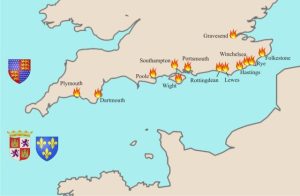Securing England’s Deep Water Ports. Naval Planning, Part Two
England and safe deep water ports
The devastation caused by French raids in the years 1337 to 1340 made the safety of ports a priority. Several key ports had been ransacked, Southampton, home of a royal castle and a port of choice for wine convoys was amongst them. Portsmouth, and the Isle of Wight, so important as a protective shield around the Solent and in the passage into Southampton Water, were also found to be lacking.

Naval Considerations: Part One an Introduction to Maritime matters c1336, Part Two Defending England’s Deep Water Ports, Part Three England’s continental ports, Part Four Planning for Naval Superiority in the Hundred Years War, Part Five Protecting Merchant Shipping
Response to the French raids
These, and other, ports along the south coast saw major investment. Southampton and Portsmouth were the main departure points for English armies to Aquitaine, Brittany, or Normandy. They were also the ports that saw the highest volume of trade from those regions and from merchants sailing from the Iberian Peninsula or the Mediterranean. The anger that the raids caused is illustrated by what happened to the men who orchestrated those attacks when they were captured during the battle of Sluys. The two commanders would both have commanded large ransoms. One was hanged from the mast of his ship, the other beheaded shortly after the battle. By the mid-1340s the Solent and surrounding area bristled with armaments, embankments, additional men-at-arms, and improvements to the walled defences were underway.
Logistics of improving defences
There are many records to show how this was achieved. For example, the Calendar of Close Rolls includes specific orders for Oak to be taken to various ports for use in the construction of defences, in this case from the forest of Clarendon, near Salisbury, to Southampton:
To Giles de Bello Campo, keeper of the forest of Claryndon, or to him who supplies his place. Order to deliver to Stephen de Buterle, the king’s yeoman, 6 oaks which he shall choose in a place called Mulchet in that forest, without delay, to be taken to Southampton in aid of enclosing that town against the attacks of alien enemies, according to the advice of Edmund de la Beche, the king’s clerk, and of other lieges staying for the defence of that town by the king’s order. CCR 1339-1341 p158
Prioritisation also took place. The immediate concern of King and Council was to prevent a reoccurrence of the 1338 raid on Southampton. It was the first major raid on a major port and had sent shock waves through the administration. An inquiry into the causes was conducted and the results of this informed planning. Construction of temporary and more permanent defences were begun; artillery and arms were procured.
Construction of port defences
As Southampton and the approach down Southampton Water became a major construction site, attention turned to the Solent. Portsmouth too was raided, and as it was easier for a French raiding fleet to reach, it was perceived as being a vulnerable priority. It resulted in orders being given for men-at-arms to be dispatched for the defence of maritime lands around Portsmouth, a necessity whilst planning of the towns coastal defences were planned and in the initial stages of construction. The Calendar of Close Rolls shows this change in priorities:
To Edmund de la Beche, the king’s clerk. Order to supersede the distraint made on the abbot of Hyde, near Winchester to find six men at arms at Southampton, while he finds the six men at Portesmuth for the custody of the maritime land there, because the king considers that the maritime land at Portesmuth is in more danger than at Southampton as Richard earl of Arundel, keeper of the maritime land in those parts testifies CCR 1339 – 1341 p218
In the straights of Dover, there too was development of ports. Sandwich saw logistical improvements made to the anchorage at Sandwich Haven, embankments were added, and Dover continued to pose a considerable threat to any would be assailant in the area. England secured her primary ports as a matter of urgency.
Improving ‘The Watch’
Reinforcing the ports was not, on its own, enough to ensure safety. The King and his Council also expected the watch to be improved. Vigilance was as critical as arms, as several of the French raids had, according to some accounts, been undertaken without their approach being spotted, or resistance being offered. The Calendar of Close Rolls shows the way this was attended to for people living close to ports in the aftermath of the raids of 1338-40:
To Edmund de la Beche, Richard de Penle and Stephen de Bitterle, keepers of the town of Southampton. Order to desist from distraints on Thomas, precentor of the church of St Mary of that town, for finding men for that custody beyond the two armed men and four archers whom he finds for the garrison of the town, as he has shown the king that although he paid 7l in aid of the walling and enclosing of the town, and finds the said men, and he is not sufficient to support such a charge and his church and manse, where he dwells, are without the walls of the town, yet the keepers distrain him to find other men for the watches upon the walls whereupon he has besought the king to provide a remedy. CCR 1339-1341 p215
Naval Planning: Part One, an introduction into England’s maritime considerations at the start of the Hundred Years War
Naval Planning: Naval Strategy, 1340

Pingback: Naval Planning in the Hundred Years War. Part One, an introduction to English considerations – The Hundred Years War
Pingback: Owain ap Thomas’ manifesto - The Hundred Years War